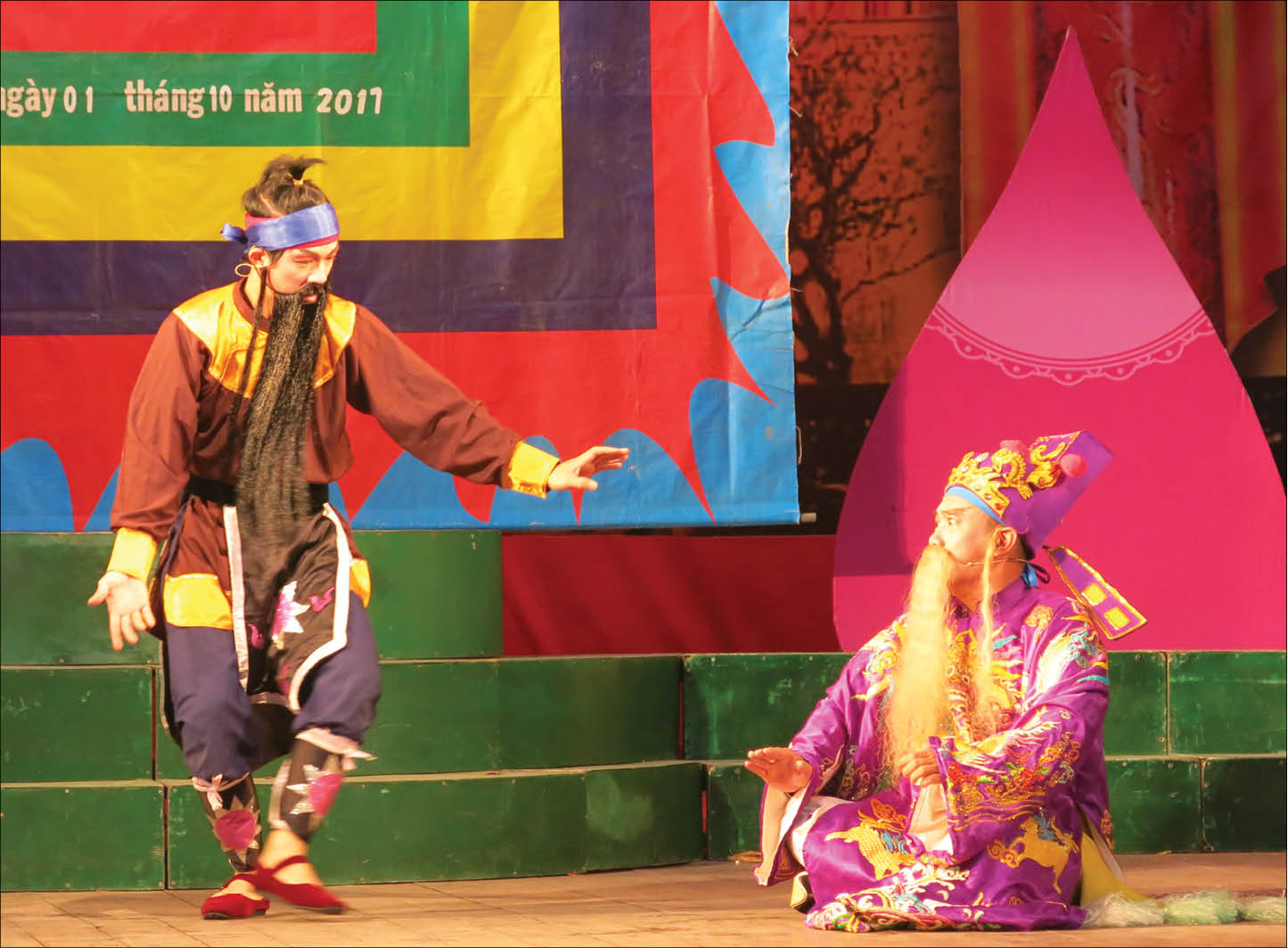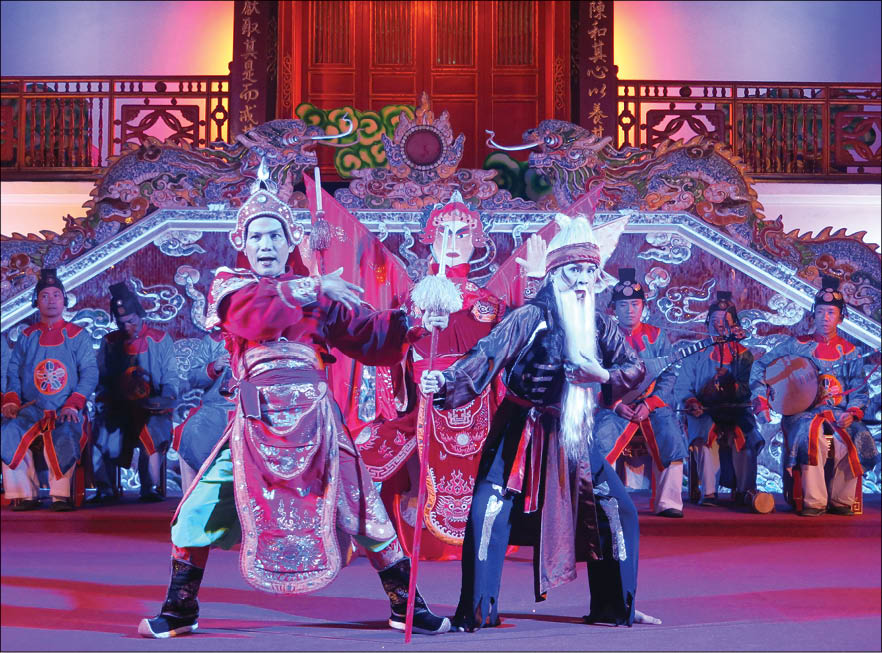
Excerpt from "Manh Luong Taming a Horse"
Not having the chance to teach tuồng for the last 8 years
When she graduated from the tuồng major 7 years ago from the College of Culture and Art in 2009, Bui Thi Diu was recruited as a tuồng teacher at the college. But, since then, she has not been able to teach a lesson about tuồng because there has been no student. For four years of junior college and three years of college (sponsored by the Ford Foundation), Diu's class is the last class studying tuồng. After that course, the school could not open any more tuồng class.
Ms. Diu said, "I studied 7 years but now I could not teach tuồng. At first I was very sad. Doing student admission programs for many years, I wish there were a few students who would register so I could teach. However, I was just waiting year after year. Often, I would miss tuồng so much that I would go over to Theatre of Hue Traditional and Royal Art to see the others perform.
Under the same circumstances, in the recent years, teacher Tran Duc Huan, who is a tuồng teacher of the College of Culture and Art can no longer teach this subject. After the class of Ms. Diu, Mr. Huan also has no student. Both Ms. Diu and Mr. Huan were trained in royal court singing alongside with tuồng, so they now teach dance and performance techniques.
Mr. Huan said: "I haven't had a student for 8 years. I think perhaps I might have forgotten this art form. I really miss the atmosphere of teaching and learning tuồng in the old days. In my time, entering the art college was very difficult. The admission rate was 1 to 15, 17 people. You had to sing well and have a nice body. We had to prepare for the exam for months. Sitting next to him, Ms. Diu continued: "At that time, I was in the 9th grade. I had to pack my belongings and went from Quang Tri to Hue for the recruitment exam. At that time, there was a very strict selection. Only 17 people were selected to learn tuồng from a pool of a hundred people. Now, we only hope for some students to enrol in the tuồng major."
Every year, the College of Culture and Art go to lower-secondary schools and high schools in the province and neighboring provinces to enroll students, but no one wants to follow the tuồng art. Mr. Huan said sadly: "When we introduced about the tuồng art, they all laughed. We have been to many families to encourage parents to let their children follow the art, but it is all helpless. It all makes sense though, because if the career cannot support you financially, no one dares to let their children follow it.
Mr. Nguyen Van Thanh, Chairman of the Stage Artists Association worried: "For many years, the School of Culture and Art could not recruit students, we are worried about the next generation. Work and payroll is too difficult. If there is no available job when graduating, no students dare enter the profession. Moreover, in the trend of integration, the audience is turning away from the traditional arts. Even if they learned the art, there would be no audience to perform to.

Performances at Duyet Thi Duong for tourists
Keeping Hue tuồng from disappearing
In the difficult trend, Theatre of Hue Traditional and Royal Art is self-training the next generation to preserve Hue tuồng. People's ArtistBach Hac, director of the theatre said: "Without human resources, the theatre must find ways to exploit manpower. The criterion of our theatre when recruiting people is that they have to be able to do three things: dance, singing and perform tuồng. In the process of working with them, we could see their qualities and we try hard to train these young artists. Recently, in a young talent contest, the 8 tuồng excerpts competing in the contest all received prizes. Most of them were dancers but the theatre trained them to be tuồng performers. Then her voice was ebullient: "Who says Hue tuồng is dying out? It's not. Every year, the theatre itself educates its people and now, we still have people to train. "
In this way, now the theatre has the Thanh Binh troupe of 40-50 tuồng performers. To introduce and promote tuồng, the Theatre of Hue Traditional and Royal Art has 2 tuồng performances everyday along with the royal court music and dance at Duyet Thi Duong for tourists. With the viewpoint that intangible heritage is the soul of the object of the leadership of Hue Monuments Conservation Center, in the upcoming time, in addition to performances at Duyet Thi Duong, the theatre will hold traditional art performances in some new location in the monument sites to attract tourists.
People's Artist Bach Hac shared: "The advantage of the theatre is that it is within the relics. There are beautiful places, suitable for traditional arts performances. Maybe, we will perform some tuồng excerpts or introduce tuồng masks for tourists. Instead of performing a 20-30 minute excerpt which will make the guests bored because they do not understand, we do not use much words but increase the choreography to show the character. Or maybe it does not have to be a full tuồng excerpt, but a 10-minute performance. The 10 minutes is worth watching to understand Hue's royal tuồng art."
Another good news is that in 2016, Hue has 8 students studying tuồng at Hanoi Academy of Theater and Cinema. This is the project of training actors and musicians for the professional tuồng, chèo, cải lương, and folk drama arts in the country in the period 2016-2020 of the Department of Performing Arts - Ministry of Culture, Sports and Tourism. In addition to general knowledge subjects, the students are guided by artisans and artists of Hue about Hue tuồng. This is an urgent solution to preserve the art endangered of dying out.
Mr. Nguyen Van Thanh said, in some ways, the Association of Performing Artists and the Theatre of Hue Traditional and Royal Art are trying to preserve the old traditions. However, if we want to keep the tuồng art, we need to have long-term policies because the selection of actors are very strict. In the traditional arts, it is very difficult to learn the hardest tuồng pieces because they require the combination of dance, vocal and psychological expression, and also good voice, beauty and even health.
Preserving traditional arts, which include tuồng, is a story with yet no end. We would like to use People's Artist Bach Hac's statement as a conclusion to this article: "How can the Chinese Theatres still retain their good actors? How can Japanese Noh drama, a traditional drama, still captivate young artists? Because they have a good treatment for the artists. "
Story, photos: MINH HIEN